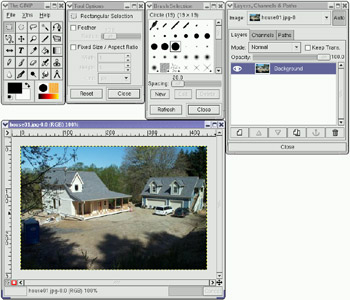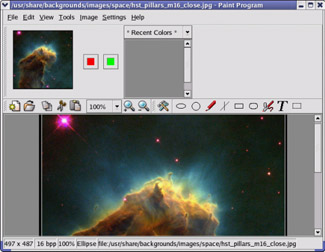Working with Graphics
Working with Graphics
Tools for creating and manipulating graphics are becoming both more plentiful and more powerful in Red Hat Linux. Leading the list is the GNU Image Manipulation Program (GIMP). GIMP lets you compose and author images as well as retouch photographs. Other tools that come with Red Hat Linux for creating graphics include ksnapshot (a program for taking screen captures) and kpaint (for working with bitmap images).
| Cross-Reference? |
See Chapter 8 for descriptions of other multimedia applications, such as the gphoto window for working with images from digital cameras. |
Manipulating images with GIMP
The GIMP is a free software program that comes with Red Hat Linux for manipulating photographs and graphical images. To create images with GIMP, you can either import a drawing, photograph, or 3D-image, or you can create one from scratch. You can start GIMP from the system menu by clicking Graphics ? The GIMP or by typing gimp& from a Terminal window.
Figure 6-13 shows an example of GIMP.

Figure 6-13: GIMP is a powerful tool for graphic manipulation.
| Note? |
If GIMP is not on your system or is not installed properly, you can install it from CD # 1 that comes with this book. Alternatively, you can obtain the latest copy of GIMP from www.gimp.org. |
In many ways, GIMP is similar to Adobe Photoshop. Some people feel that GIMP's scripting features are comparable to, or even better than, Actions in Adobe Photoshop. One capability that GIMP lacks, however, is support for CMYK separations.
Taking screen captures
If you want to show examples of the work you do on Red Hat Linux, you can use the Screen Capture program to capture screen images. (The ksnapshot command is part of the kdegraphics package contained on CD #2.)
To open Screen Capture, from the Red Hat menu click Graphics ? Screen Capture Program (or type ksnapshot). Figure 6-14 shows an example of the Screen Capture program.

Figure 6-14: Grab a picture of your desktop or selected window with Screen Capture.
When Screen Capture first opens, it takes a snapshot of the full desktop. Buttons on the window let you:
-
Print Snapshot — Have the snapshot sent to your printer.
-
Save Snapshot — Save the snapshot to a file in X bitmap, windows icon, PNG, portable pixmap, JPEG, X pixmap, Encapsulated PostScript, or Windows BMP formats.
-
New Snapshot — Take a new snapshot. With "Only grab the window…" selected, you can click a window to capture that window alone.
Modifying images with KPaint
Using the KPaint window, a utility that comes with KDE (in the kdegraphics package on CD #2), you can work with and convert images in several formats. Figure 6-15 shows an example of KPaint.

Figure 6-15: Edit bitmap images with KPaint.
Start KPaint from either the desktop (from the Red Hat menu, click Graphics? More Graphics Applications ? Paint Program) or from a Terminal window (/usr/bin/kpaint&). Start with either a blank canvas or by opening an image in one of the supported formats (File ? Open, browse for a file, and then select OK). Look in the /usr/share/backgrounds directory for graphics to try.
The painting tools let you draw ovals, boxes, lines, and other shapes. You can save the file to several different formats, including MS Windows pixmaps, Encapsulated PostScript image, MS Windows icons, JPEG, PNG, PNM, TIFF, X bitmap, or X Window pixmap.







